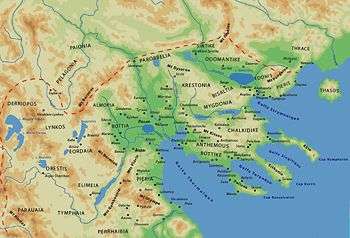Bisaltia

Bisaltia (Greek: Βισαλτία) or Bisaltica was an ancient region extending from the river Strymon and Lake Cercinitis on the east to Crestonia on the west. The eponymous inhabitants, known as the Bisaltae, were a Thracian people. The most important town in Bisaltia was the Greek city of Argilus.[1] There was a river named Bisaltes in the region, which has not been certainly identified.
Bisaltia, along with Crestonia, was ruled by a Thracian prince at the time of the invasion of Xerxes I of Persia, but by the onset of the Peloponnesian War it was annexed to Macedon.
In Roman times, Bisaltia crossed a branch of the via Egnatia, in which the roman sources (Itineraria) mention four horses change stations : Trinlo (=Tragilos), Graero, Arason (=Arolos) and Euporia.[2] In various sites of Bisaltia have been found so far several interesting inscriptions of imperial times.[3]
Today, Bisaltia is contained within the Serres regional unit and part of the Thessaloniki regional unit in Greece.
References
- ↑ An Inventory of Archaic and Classical Poleis: An Investigation Conducted by The Copenhagen Polis Centre for the Danish National Research Foundation by Mogens Herman Hansen,2005,ISBN 0-19-814099-1,page 810,"There were three polis in Bisaltia of which one was considered a colony of Andros"
- ↑ D. C. Samsaris, Historical Geography of Eastern Macedonia during the Antiquity (in Greek), Thessaloniki 1976 (Society for Macedonian Studies), p. 24, 117-119
- ↑ D. C. Samsaris, La vallée du Bas-Strymon á l’ époque impériale (Contribution épigraphique á la topographie, l’ onomastique, l’ histoire et aux cultes de la province romaine de Macédoine), Dodona 18 (1989), fasc. 1, p. 215-225, n. 1-23